13 Nov 2022
Kate Parkinson provides intriguing answers to common questions around these genetic variations in companion felids.

While coat colour can be linked to a range of medical conditions, many of these cases may be due to sex linkage rather than coat colour.
A few sex-linked genes control each of the main cat coat colour characteristics: black/orange, dilute/non-dilute, agouti/non-agouti, tabby/non-tabby and white/non-white. As the tortoiseshell coat colour is produced by a female cat with two X chromosomes, possessing one copy of the black and one copy of the orange allele on each of its two X chromosomes, normal male cats with XY chromosomes cannot have tortoiseshell coloration. Male tortoiseshell cats are genetic chimeras, rare mutants or display a condition like Klinefelter syndrome in humans.
Many vets stereotype tortoiseshell cats as being more temperamental than cats of other colours, but little published work exists on cat coat colour and temperament. Some surveys have shown that humans describe tortoiseshell pets as more aggressive compared to cats of other colours, but this evidence is often subject to the owner’s descriptions of their pets and, therefore, potentially biased. Most humans prefer more colourful pets over darker animals – often leading to a shortage of homes for black cats, particularly. Cat coat colour has been linked to several diseases, including inherited deafness in white cats, FeLV and hyperthyroidism.
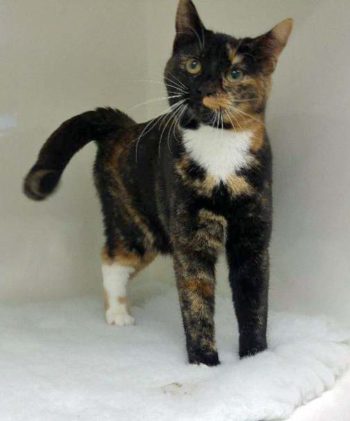
Many well-established stereotypes link a cat’s temperament and coat colour (Figure 1).
Let’s face it, most vets have blamed a tortoiseshell cat’s bad behaviour on her coat.
While “naughty torties” and “laid-back blacks” certainly exist in general practice, does a relationship really exist between a cat’s colour and its temperament? And how is cat coat colour linked to other medical conditions?
The genes controlling cat coat colour are located on the X chromosome. These genes have two mutually exclusive alleles: black and ginger.
A female cat with two X chromosomes carrying one copy of the ginger allele and one copy of the black allele will be a tortoiseshell. Female cats inherit a ginger coat only if they carry the ginger gene on both X chromosomes. As the black gene is much more common in the cat population, ginger cats are usually male.
A male cat with one X and one Y chromosome will be either black or ginger depending on which allele he carries on his single X chromosome. An XY male can never be tortoiseshell, as this colouration relies on simultaneous expression of the black and ginger allele.
Male tortoiseshell cats are, therefore, either males with Klinefelter syndrome (XXY) or rare genetic chimeras derived from different zygotes (XX‑XY or XY-XY).
Fertile male tortoiseshell cats can also occur due to mutation of the orange to the black gene in cells during fetal development, which is extremely rare.
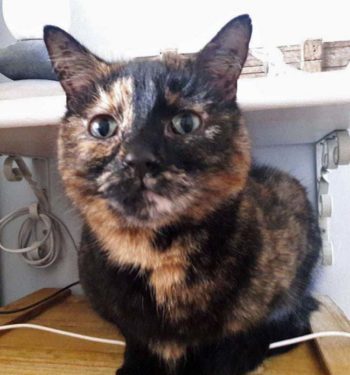
Harry (Figure 2) is a five-year-old domestic shorthair tortoiseshell male cat.
“I chose Harry purely on his cuteness,” said his owner Natalie.
“He was a bit of a fluffy mess with blue eyes. We booked him an appointment at the vet for about a week after we got him. When I booked in a tortie called Harry, the receptionist questioned it, but I thought she just didn’t hear me.
“When we got to the vets, she asked to take him next door, and we could hear a few voices fussing over him and saying ‘oh wow, you are a boy’.
“When she returned, she explained that none of them had ever seen a male tortie and all wanted pictures. They googled it and said it was less than one per cent chance of having him, so we were very lucky.”
Harry has no current medical problems and behaves like any normal cat.
Blue and grey cats carry dilute copies of the black alleles, and cream or yellow cats carry dilute copies of the orange allele.
White cats carry a white masking gene, which allows the white colour to mask the true colour of the cat. This gene is dominant, so any cat carrying this gene will be white, no matter what other coat colour and pattern allele it possesses.
White-spotted cats carry a white gene with variable expression, creating white bibs, spots or paws rather than complete coat coverage. Agouti and tabby patterns are controlled by different genes, which can be co-expressed with other colour alleles (Figures 3 and 4).
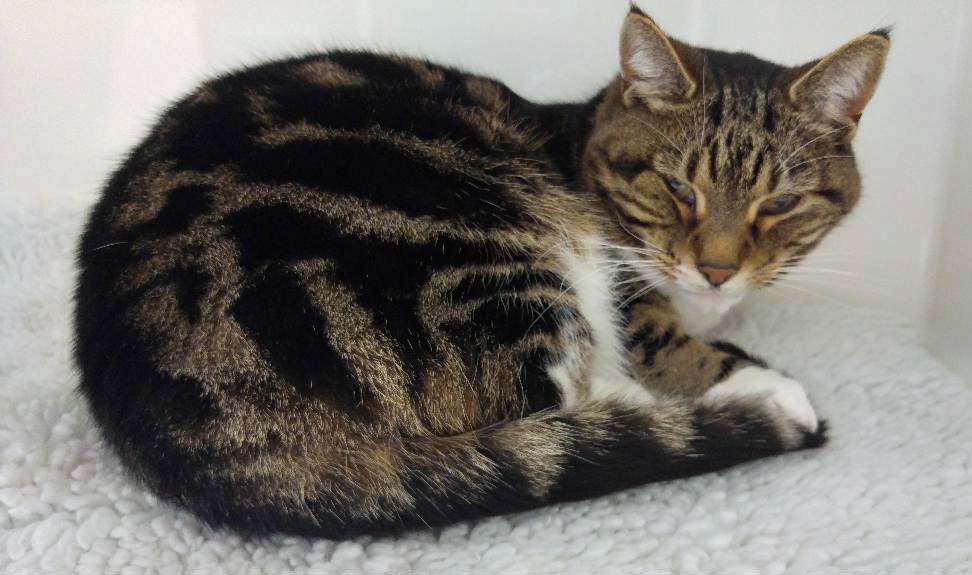
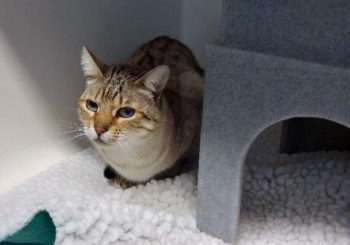
Colourpoint cats have a dark tail, ears, paws and face due to a temperature-sensitive mutation in an enzyme that creates pigment.
Little or no pigment is produced, except in areas where the skin is slightly cooler. Body temperature drops as cats age, so many will darken during the first year of their life. Caution is recommended when clipping as spots in the coat often grow back darker.
Inherited congenital deafness is linked to white coat colour in cats. White cats carry the pleiotropic gene W. Pleiotropic genes have multiple effects.
In the case of white cats, the W gene is responsible for white coat, blue eyes and deafness. W is a dominant gene with reduced penetrance for deafness and blue eyes, so while all cats that carry the W gene will have a white coat, not all of them will have blue eyes or be deaf.
However, blue eyes and deafness are strongly linked – so a white cat with blue eyes is three to five times more likely to be deaf than a white cat with green eyes (International Cat Care, 2018).
The belief that tortoiseshell cats are feistier than cats of different colours dates to at least the 19th century.
WG Stables, a Victorian author, wrote in his 1877 book Cats: Their Points and Characteristics: “Tortoiseshell cats are, as a rule, neither very large, or very prepossessing. They have a sinister look about them, as though they would as soon bite you as not. I question too if they exhibit the same affection as other species”.
He also described tortoiseshell cats in The Domestic Cat (1876) as “usually sour-tempered, unfriendly little things to all save those who own and love them”, an opinion which most people would find unduly harsh.
However, CH Ross expressed an opposing opinion in The Book of Cats (1868), stating: “Tortoiseshell cats are very elegant, though delicate in their form, and are, at the same time, very active, and among the most attached and grateful of the whole race”.
Humans often perceive tortoiseshell cats as less tolerant, while orange cats are seen to be friendlier, and white cats shyer and quieter (Delgado et al, 2015).
These perceptions may be self-fulfilling (the vet expects the cat to be more aggressive and handles it more forcefully, which increases the cat’s anxiety), or a myth perpetuated by the media.
Until recently, little research had been carried out into the link between coat colour and temperament.
An online study in 2016 investigated the possible relationship between cat coat colour and aggressive behaviour. Stelow et al (2016) questioned 1,274 cat owners about their cat’s characteristics and behaviour. Responders did not know the intention of the study as questions about aggression and coat colour were hidden within a much wider behavioural survey.
This study found that tortoiseshells, black and white, and grey and white cats were more frequently aggressive towards humans than cats of different colours, and female cats were more aggressive when being handled than males.
No difference was found in cats of different colours during veterinary visits.
On further examination, the Stelow study has several limitations. Participants nominated themselves, thus selecting for cat owners who were computer literate and more committed to their cats than the average owner.
In addition, the average score for aggression in this study was very low, making even small deviations from the norm significant.
As participating cats were never observed directly, these small variations could be due to owner perception. Owners of tortoiseshell cats may have heard that tortoiseshell cats were more aggressive and scored their cats accordingly.
Palacio et al (2007) studied more than 900 feline bite injuries in the Valencian Community, Spain. This found that cats involved in incidents were mostly female Siamese and the victims were usually their owners.
The incidence of aggression was also low (6.3 bites per 100,000 people) and most bites were a defensive response by the cat.
A smaller study of 332 pet cats living in 347 households in New South Wales, Australia, found no link between cat biting and breed, sex or coat pattern (Kendall and Ley, 2008). This survey relied on owner-reported information.
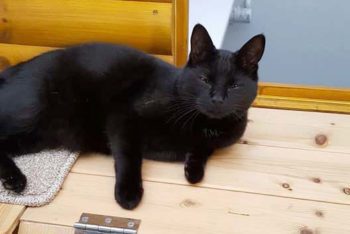
Humans show a well-documented preference for brightly coloured cats. Paler-coated cats are often preferred over cats with darker coat colour, and darker cat coat colour has been associated with areas of lower socioeconomic status in one Glasgow study (Clark, 1975).
Darker cats are notoriously more difficult to rehome than cats of paler colours. The RSPCA admits more black cats to its shelters than any other colour of cat. Black cats take longer to rehome (an average of 30 days compared to 20 days for ginger cats), and receive less interest on adoption websites (Workman and Hoffman, 2015).
At Cats Protection shelters, black cats take “two to three days longer” to rehome. Black cats often don’t photograph well and more attractive photographs of cats are more likely to catch the eye of potential rescuers.
In addition, black cats are often linked to superstition and bad omens in Western culture (Figure 5).
Other factors influencing length of shelter stay are activity (more active cats are rehomed faster), breed (exotic breeds are rehomed faster than domestic shorthair cats), age (kittens are rehomed faster than adult cats) and sex (male cats are rehomed faster than females; Janke et al, 2017).
Some evidence exists that coat colour may be linked to medical conditions such as hyperthyroidism and FeLV.
Cats with solid colour coats were found to be more susceptible to FeLV in a study of 555 cats admitted to an animal control shelter in Florida (McMichael et al, 1986).
However, infection rates were found to be statistically higher for males (13.8 per cent) than for females (5.9 per cent), so the prevalence of calico and tortoiseshell coat colours in female cats may be one explanation for this finding.
Similarly, Crossley et al (2017) studied more than 4,000 cats and found that tortoiseshell cats had an increased risk of hyperthyroidism when compared to black cats.
As female cats are more likely to be diagnosed with hyperthyroidism than males, X chromosome linkage of the tortoiseshell phenotype may again explain these findings. Coat colour had no effect on the risk of death in road traffic collisions in a recent study (Wilson et al, 2017.)
In conclusion, while coat colour can be linked to a range of medical conditions, many of these cases may be due to sex linkage rather than coat colour.
Although it is a widely held tenet (and has been for at least 100 years) that tortoiseshell cats can be more temperamental than cats of solid colour, cats in general show low levels of aggression towards humans.
Coat colour is important in shelter adoptions as potential adopters often tend towards colourful cats, and black cats in general take longer to rehome.
Veterinarians should beware of sweeping generalisations, but keep in mind that tortoiseshells, grey and white, and black and white cats have been found to have increased levels of aggression reported by their owners.
This information could help people select their next pet cat.